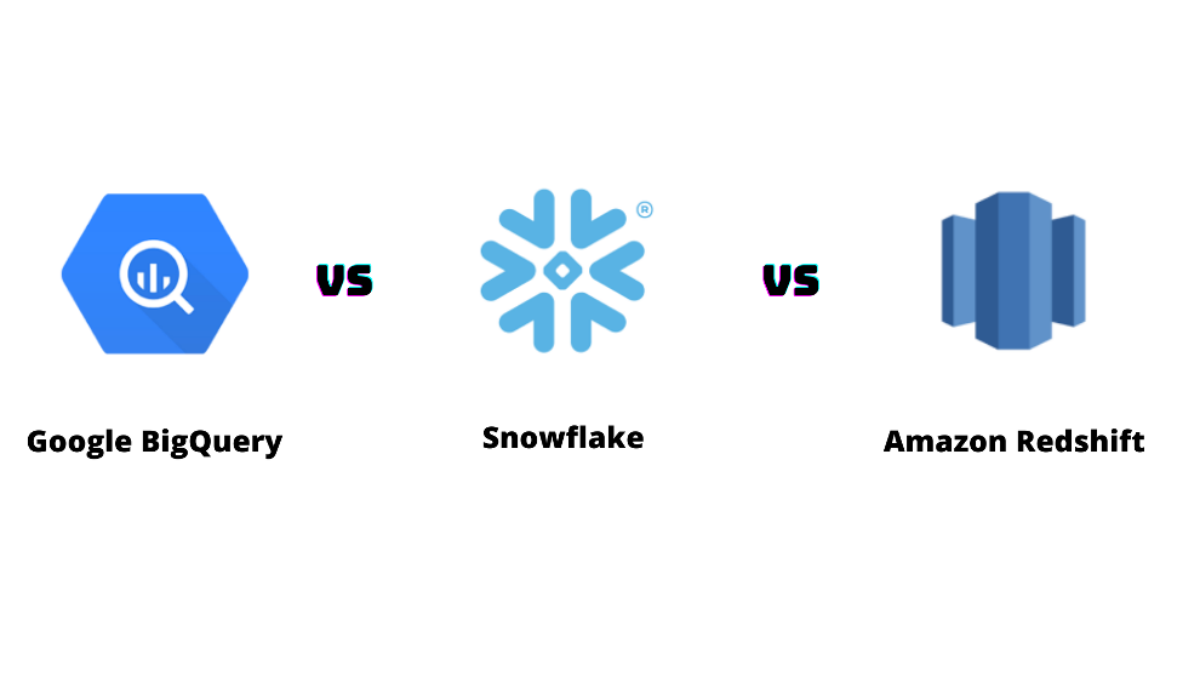BigQuery VS Snowflake VS Redshift: 5 Major Differences
by 20/01/2022 17:220

According to the IDC Whitepaper, the Global Datasphere is expected to grow to 175 Zettabytes by 2025. In an age in which enterprises are continuously looking for ways to enhance day-to-day data handling and seek techniques to reduce their cost of operations, Data Warehouses have created a niche for themselves. Companies are shifting to Cloud-based Data Warehouses with cheaper upfront costs, increased scalability, and performance. Products and services from enterprises such as Snowflake, Amazon, and Google Cloud offer a whole range of features to considerably speed up the key stages of data storing, processing and loading.
Introduction to Google BigQuery, Snowflake & Amazon Redshift
Amazon Redshift
Redshift is a one of the most popular Cloud-based Data Warehouse provided by AWS. It can handle petabyte-scale workloads. It also lets you leverage standard SQL to query aggregate a colossal volume of Semi-Structured & Structured Data in your Operational Database, Data Warehouse, and Data Lake. Moreover, it offers Big Data Analytics and Machine Learning approaches to further aggregate data.
Google BigQuery
In the Forrester WaveTM Cloud Data Warehouse – Q1 2021 study, Google was named a Leader. Google BigQuery received a 5/5 score from Forrester for facilitating vertical and horizontal use cases.
Google BigQuery is a MultiCloud Data Warehouse. Its serverless architecture allows you to run SQL queries to solve your company’s most critical problems without having to worry about managing infrastructure. The platform is designed to query/store massive datasets in a matter of seconds, utilizing super-fast SQL searches against terabytes of datasets, and providing businesses with real-time data insights.
Snowflake
Snowflake is a Cloud-based Warehousing platform that provides you with a framework that is easy to use, faster and much more adaptable than traditional Data Warehouses. Since Snowflake is completely Cloud-based, it features a robust SaaS (Software as a Service) architecture. It simplifies data processing by letting users do operations such as data blending, analysis, and transformations on a range of data formats using SQL. Snowflake’s multi-tenant architecture enables real-time data sharing throughout your organization.
Key Differentiators that Drive BigQuery vs Snowflake vs Redshift Decision
As technology now offers a more efficient way of storing and analyzing a company’s Big Data, the Data Warehousing Market is believed to grow at a 12% CAGR (Compound Annual Growth Rate) between 2019 and 2025. There are a plethora of Data Warehouse platforms available in the market today. Some of the prominent leaders are Amazon Redshift, Google BigQuery, and Snowflake. Choosing the best Data Warehouse can be challenging. To make it easy, here’s a list of some factors that will help to make the right decision:
- Architecture
- Maintenance & Server Management
- Pricing
- Security
- Use Case
1) Architecture
While selecting the right Data Warehouse, it is important to understand the basic underlying architecture of the Data Warehouse. From this, you will gain deep insights into how this structure affects scalability, cost, performance, and other features.
- Google BigQuery: Google BigQuery is a cloud serverless platform that is based on its major component, the Dremel. It supports the Massive Parallel Processing Architecture (MPP) which is used to search data by reading thousands of rows in a second. The Google BigQuery Architecture shared-nothing architecture in which data is stored in replicated and distributed units and handled in Compute clusters. Google BigQuery’s structure is adaptable, allowing various users to move their data to a Data Warehouse and to begin data analysis using easy to complex SQL queries.
- Snowflake: Snowflake Architecture is a hybrid system that combines both traditional shared-disk and shared-nothing architectural aspects of the database. It’s native to the Cloud yet integrates a novel SQL query engine with 3 key layers: Database Storage, Query Process, and Cloud Service. The data repository contains centralized one-copy data that all users from all independent Computing nodes can access. It also contains clusters which are formed of nodes that locally store portions of all the data.
- Amazon Redshift: AWS Redshift is developed with the Massively Parallel Processing (MPP) shared-nothing architecture. It consists of compute node Data Warehouse clusters that are divided into several components. Each Compute Node contains a leader that retains the unit code. The architectural system of Amazon Redshift can interface with client applications such as Standard JDBC and ODBC drivers and can be included in most current SQL customer applications, business intelligence (BI) tools, and data mining tools.
2) Maintenance & Server Management
The day-to-day management of Data Warehouses can be automated or done manually. This depends on the size of the firm and the data requirements. Let’s compare the maintenance required for the Snowflake, Google BigQuery & AWS Redshift:
- Google BigQuery: Google BigQuery is a serverless system since Google handles the majority of activities on Google’s Cloud Platform. No sizing is required while setting it up as it has separated Storage and Compute nodes. In terms of maintenance, the end-user needs little upkeep.
- Snowflake: Here, you’re not required to set up Storage and Compute power as they are separated and are handled by the Cloud provider. Snowflake is considered to be a more serverless management system since all operations occur within the Cloud provider, hence the end-users require near-zero maintenance.
- Amazon Redshift: Amazon Redshift is considered a self-managing system where human interaction and the on-site implementation of both hardware and software components will be required in many of its operations. It demands that the necessary Storage and Compute clusters are set up as they are not separated. You need to design data workflows to meet resource size. In terms of maintenance, it demands the user to maintain its tables regularly.
3) Pricing
Costs can be calculated in various ways by vendors. To estimate costs, organizations should know how much data they anticipate to integrate, store, and analyze each month. IT teams can then select a Cloud Data Warehouse vendor with the best pricing plans based on these inputs.
- Google BigQuery: BigQuery offers both On-Demand and Flat-Rate pricing plans. Although data storage ($0.020 per GB per month) and querying ($5 per TB) are all charged, data exporting, loading, and copying are all free.
- Snowflake: Snowflake offers tiered pricing based on the requirements and demands of its customers. There are 2 pricing options: On-Demand and Pre-Purchase. As storage and compute usages are distinct, the latter is charged on a per-second basis.
- Amazon Redshift: Redshift has several pricing options. Charges for on-demand pricing are determined per hour. While the initial cost is only $0.25/hour, the total cost is determined by the number of nodes in the cluster. Users pay for the volume of data they store each month using Managed Storage Pricing.
4) Security
Another important consideration when choosing a Data Warehouse service is security. It is critical to understand that the information will not be shared with harmful third parties. In reality, all 3 Data Warehouses discussed here include built-in security features to keep your data secured.
- Google BigQuery: Google BigQuery provides security at column level to check identity and access status, create security policies since all data are encrypted and sent by default. It conforms to the security requirements of Google Cloud, such as HIPAA, FedRAMP, PCI DSS, ISO/IEC, SOC 1,2, 3, and so on.
- Snowflake: Snowflake security is dependent upon the characteristics of your Cloud provider. It provides regulated access management and high levels of data protection, as it complies with most of the standards such as SOC 1 Type 2, SOC 2 Type 2, PCI DSS, HIPAA, HITRUST, etc.
- Amazon Redshift: With Amazon Redshift, AWS ensures Cloud safety. However, you are responsible for setting up login credentials and loading data encryption and SSL connections securely. Redshift meets a range of security standards like ISO, PCI, HIPAA BAA, and SOC 1, 2, 3.
5) Use Case
When assessing Data Warehousing services, a company’s particular data requirements and use case are also the key considerations to consider. Let’s take a glance at when & where you should consider the following Data Warehouses:
- Google BigQuery: Google BigQuery is great for Data Mining based organizations and enterprises with different workloads since it helps you decide on how to query your data.
- Snowflake: Snowflake is best suited to enterprises who want to cut expenses by exploiting the availability of an almost limitless, autonomous scaling and creditable performance of Cloud Data Warehouse.
- Amazon Redshift: Amazon Redshift is suited for large-scale data managing enterprises that need fast query replies. It features a flexible price model and requires no overhead administrative expenditures.
Conclusion
This post highlighted 5 major differences between BigQuery vs Snowflake vs Redshift. These key differentiators will help you choose the right Data Warehouse for your business and data needs. Apart from these major differences, there are a few other critical factors that need to be considered.
Setting up effective interfaces with data sources such as Databases, SDKs, Streaming platforms, SAAS, is one of the most important jobs that organizations must do when implementing a Cloud-based Data Warehouse. Businesses can either build up this integration manually, which would involve a significant amount of technical bandwidth and resources, or they can use automated platforms like Hevo.



